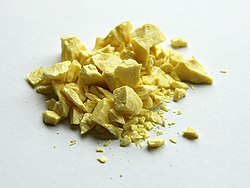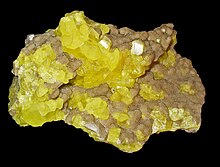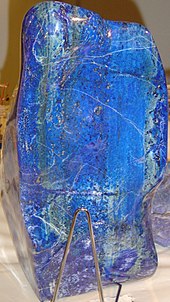Wikipedia! :)
confusing!
Sulfur
From Wikipedia, the free encyclopedia
This article is about the chemical element. For other uses, see Sulfur (disambiguation).
| |||||||||||||||||||||||||||||||||||||
| Appearance | |||||||||||||||||||||||||||||||||||||
|---|---|---|---|---|---|---|---|---|---|---|---|---|---|---|---|---|---|---|---|---|---|---|---|---|---|---|---|---|---|---|---|---|---|---|---|---|---|
Lemon yellow sintered microcrystals Spectral lines of sulfur | |||||||||||||||||||||||||||||||||||||
| General properties | |||||||||||||||||||||||||||||||||||||
| Name, symbol, number | sulfur, S, 16 | ||||||||||||||||||||||||||||||||||||
| Pronunciation | /ˈsʌlfər/ sul-fər | ||||||||||||||||||||||||||||||||||||
| Element category | nonmetal | ||||||||||||||||||||||||||||||||||||
| Group, period, block | 16, 3, p | ||||||||||||||||||||||||||||||||||||
| Standard atomic weight | 32.065(5) | ||||||||||||||||||||||||||||||||||||
| Electron configuration | [Ne] 3s2 3p4 | ||||||||||||||||||||||||||||||||||||
| Electrons per shell | 2, 8, 6 (Image) | ||||||||||||||||||||||||||||||||||||
| Physical properties | |||||||||||||||||||||||||||||||||||||
| Phase | solid | ||||||||||||||||||||||||||||||||||||
| Density (near r.t.) | (alpha) 2.07 g·cm−3 | ||||||||||||||||||||||||||||||||||||
| Density (near r.t.) | (beta) 1.96 g·cm−3 | ||||||||||||||||||||||||||||||||||||
| Density (near r.t.) | (gamma) 1.92 g·cm−3 | ||||||||||||||||||||||||||||||||||||
| Liquid density at m.p. | 1.819 g·cm−3 | ||||||||||||||||||||||||||||||||||||
| Melting point | 388.36 K, 115.21 °C, 239.38 °F | ||||||||||||||||||||||||||||||||||||
| Boiling point | 717.8 K, 444.6 °C, 832.3 °F | ||||||||||||||||||||||||||||||||||||
| Critical point | 1314 K, 20.7 MPa | ||||||||||||||||||||||||||||||||||||
| Heat of fusion | (mono) 1.727 kJ·mol−1 | ||||||||||||||||||||||||||||||||||||
| Heat of vaporization | (mono) 45 kJ·mol−1 | ||||||||||||||||||||||||||||||||||||
| Molar heat capacity | 22.75 J·mol−1·K−1 | ||||||||||||||||||||||||||||||||||||
| Vapor pressure | |||||||||||||||||||||||||||||||||||||
| |||||||||||||||||||||||||||||||||||||
| Atomic properties | |||||||||||||||||||||||||||||||||||||
| Oxidation states | 6, 5, 4, 3, 2, 1, -1, -2 (strongly acidic oxide) | ||||||||||||||||||||||||||||||||||||
| Electronegativity | 2.58 (Pauling scale) | ||||||||||||||||||||||||||||||||||||
| Ionization energies (more) | 1st: 999.6 kJ·mol−1 | ||||||||||||||||||||||||||||||||||||
| 2nd: 2252 kJ·mol−1 | |||||||||||||||||||||||||||||||||||||
| 3rd: 3357 kJ·mol−1 | |||||||||||||||||||||||||||||||||||||
| Covalent radius | 105±3 pm | ||||||||||||||||||||||||||||||||||||
| Van der Waals radius | 180 pm | ||||||||||||||||||||||||||||||||||||
| Miscellanea | |||||||||||||||||||||||||||||||||||||
| Crystal structure | orthorhombic | ||||||||||||||||||||||||||||||||||||
| Magnetic ordering | diamagnetic[1] | ||||||||||||||||||||||||||||||||||||
| Electrical resistivity | (20 °C) (amorphous) 2×1015 Ω·m | ||||||||||||||||||||||||||||||||||||
| Thermal conductivity | (amorphous) 0.205 W·m−1·K−1 | ||||||||||||||||||||||||||||||||||||
| Bulk modulus | 7.7 GPa | ||||||||||||||||||||||||||||||||||||
| Mohs hardness | 2.0 | ||||||||||||||||||||||||||||||||||||
| CAS registry number | 7704-34-9 | ||||||||||||||||||||||||||||||||||||
| Most stable isotopes | |||||||||||||||||||||||||||||||||||||
| Main article: Isotopes of sulfur | |||||||||||||||||||||||||||||||||||||
| |||||||||||||||||||||||||||||||||||||
In nature, sulfur can be found as the pure element and as sulfide and sulfate minerals. Elemental sulfur crystals are commonly sought after by mineral collectors for their brightly colored polyhedron shapes. Being abundant in native form, sulfur was known in ancient times, mentioned for its uses in ancient Greece, China and Egypt. Sulfur fumes were used as fumigants, and sulfur-containing medicinal mixtures were used as balms and antiparasitics. Sulfur is referenced in the Bible as brimstone in English, with this name still used in several nonscientific terms.[2] Sulfur was considered important enough to receive its own alchemical symbol. It was needed to make the best quality of black gunpowder, and the bright yellow powder was hypothesized by alchemists to contain some of the properties of gold, which they sought to synthesize from it. In 1777, Antoine Lavoisier helped convince the scientific community that sulfur was a basic element, rather than a compound.
Elemental sulfur was once extracted from salt domes where it sometimes occurs in nearly pure form, but this method has been obsolete since the late 20th century. Today, almost all elemental sulfur is produced as a byproduct of removing sulfur-containing contaminants from natural gas and petroleum. The element's commercial uses are primarily in fertilizers, because of the relatively high requirement of plants for it, and in the manufacture of sulfuric acid, a primary industrial chemical. Other well-known uses for the element are in matches, insecticides and fungicides. Many sulfur compounds are odiferous, and the smell of odorized natural gas, skunk scent, grapefruit, and garlic is due to sulfur compounds. Hydrogen sulfide produced by living organisms imparts the characteristic odor to rotting eggs and other biological processes.
Sulfur is an essential element for all life, and is widely used in biochemical processes. In metabolic reactions, sulfur compounds serve as both fuels and respiratory (oxygen-replacing) materials for simple organisms. Sulfur in organic form is present in the vitamins biotin and thiamine, the latter being named for the Greek word for sulfur. Sulfur is an important part of many enzymes and in antioxidant molecules like glutathione and thioredoxin. Organically bonded sulfur is a component of all proteins, as the amino acids cysteine and methionine. Disulfide bonds are largely responsible for the mechanical strength and insolubility of the protein keratin, found in outer skin, hair, and feathers, and the element contributes to their pungent odor when burned.
Contents[hide] |
Characteristics
Physical
Sulfur forms polyatomic molecules with different chemical formulas, with the best-known allotrope being octasulfur, cyclo-S8. Octasulfur is a soft, bright-yellow solid with only a faint odor, similar to that of matches.[3] It melts at 115.21 °C, boils at 444.6 °C and sublimes easily.[2] At 95.2 °C, below its melting temperature, cyclo-octasulfur changes from α-octasulfur to the β-polymorph.[4] The structure of the S8 ring is virtually unchanged by this phase change, which affects the intermolecular interactions. Between its melting and boiling temperatures, octasulfur changes its allotrope again, turning from β-octasulfur to γ-sulfur, again accompanied by a lower density but increased viscosity due to the formation of polymers.[4] At even higher temperatures, however, the viscosity decreases as depolymerization occurs. Molten sulfur assumes a dark red color above 200 °C. The density of sulfur is about 2 g·cm−3, depending on the allotrope; all of its stable allotropes are excellent electrical insulators.Chemical
Sulfur burns with a blue flame concomitant with formation of sulfur dioxide, notable for its peculiar suffocating odor. Sulfur is insoluble in water but soluble in carbon disulfide and, to a lesser extent, in other nonpolar organic solvents, such as benzene and toluene. The first and the second ionization energies of sulfur are 999.6 and 2252 kJ·mol−1, respectively. Despite such figures, S2+ is rare, S4, 6+ being more common. The fourth and sixth ionization energies are 4556 and 8495.8 kJ·mol−1, the magnitude of the figures caused by electron transfer between orbitals; these states are only stable with strong oxidants as fluorine, oxygen, and chlorine.Allotropes
Main article: Allotropes of sulfur
Sulfur forms more than 30 solid allotropes, more than any other element.[5] Besides S8, several other rings are known.[6] Removing one atom from the crown gives S7, which is more deeply yellow than S8. HPLC analysis of "elemental sulfur" reveals an equilibrium mixture of mainly S8, but with S7 and small amounts of S6.[7] Larger rings have been prepared, including S12 and S18.[8][9]Amorphous or "plastic" sulfur is produced by rapid cooling of molten sulfur—for example, by pouring it into cold water. X-ray crystallography studies show that the amorphous form may have a helical structure with eight atoms per turn. The long coiled polymeric molecules cause the brownish substance to be elastic, and in bulk this form has the feel of crude rubber. This form is metastable at room temperature and gradually reverts to crystalline molecular allotrope, which is no longer elastic. This process happens within a matter of hours to days, but can be rapidly catalyzed.
Isotopes
Main article: Isotopes of sulfur
Sulfur has 25 known isotopes, four of which are stable: 32S (95.02%), 33S (0.75%), 34S (4.21%), and 36S (0.02%). Other than 35S, with a half-life of 87 days and formed in cosmic ray spallation of 40Ar, the radioactive isotopes of sulfur have half-lives less than 170 minutes.When sulfide minerals are precipitated, isotopic equilibration among solids and liquid may cause small differences in the δS-34 values of co-genetic minerals. The differences between minerals can be used to estimate the temperature of equilibration. The δC-13 and δS-34 of coexisting carbonates and sulfides can be used to determine the pH and oxygen fugacity of the ore-bearing fluid during ore formation.
In most forest ecosystems, sulfate is derived mostly from the atmosphere; weathering of ore minerals and evaporites contribute some sulfur. Sulfur with a distinctive isotopic composition has been used to identify pollution sources, and enriched sulfur has been added as a tracer in hydrologic studies. Differences in the natural abundances can be used in systems where there is sufficient variation in the 34S of ecosystem components. Rocky Mountain lakes thought to be dominated by atmospheric sources of sulfate have been found to have different δ34S values from lakes believed to be dominated by watershed sources of sulfate.
Natural occurrence

Most of the yellow and orange hues of Io are due to elemental sulfur and sulfur compounds, produced by active volcanoes.

Native sulfur crystals, Iran

Sulfur crystals, khanegiran, Iran

A man carrying sulfur blocks from Kawah Ijen, a volcano in East Java, Indonesia (photo 2009)
Sulfur, usually as sulfide, is present in many types of meteorites. Ordinary chondrites contain on average 2.1% sulfur, and carbonaceous chondrites may contain as much as 6.6%. It is normally present as troilite (FeS), but there are exceptions, with carbonaceous chondrites containing free sulfur, sulfates and other sulfur compounds.[11] The distinctive colors of Jupiter's volcanic moon Io are attributed to various forms of molten, solid and gaseous sulfur.[12]
On Earth, elemental sulfur can be found near hot springs and volcanic regions in many parts of the world, especially along the Pacific Ring of Fire; such volcanic deposits are currently mined in Indonesia, Chile, and Japan. Such deposits are polycrystalline, with the largest documented single crystal measuring 22×16×11 cm.[13] Historically, Sicily was a large source of sulfur in the Industrial Revolution.[14]
Significant deposits of elemental sulfur, believed to have been (and are still being) synthesised by anaerobic bacteria on sulfate minerals like gypsum, exist in salt domes along the coast of the Gulf of Mexico, and in evaporites in eastern Europe and western Asia. Native sulfur may be produced by geological processes alone. Fossil-based sulfur deposits from salt domes have until recently been the basis for commercial production in the United States, Poland, Russia, Turkmenistan, and Ukraine.[15] Such sources are now of secondary commercial importance, and most are no longer worked.
Common naturally-occurring sulfur compounds include the sulfide minerals, such as pyrite (iron sulfide), cinnabar (mercury sulfide), galena (lead sulfide), sphalerite (zinc sulfide) and stibnite (antimony sulfide); and the sulfates, such as gypsum (calcium sulfate), alunite (potassium aluminium sulfate), and barite (barium sulfate). On Earth, just as upon Jupiter's moon Io, elemental sulfur occurs naturally in volcanic emissions, including emissions from hydrothermal vents.
Production
Sulfur may be found by itself and historically was usually obtained in this way, while pyrite has been a source of sulfur via sulfuric acid.[16] The Sicilian process was used in ancient times to obtain sulfur from rocks present in volcanic regions of Sicily: sulfur deposits were piled and stacked in brick kilns built on sloping hillsides, with airspaces between them. Then, powdered sulfur was put on top of the deposit and ignited, causing the deposits to melt down the hills. Today's sulfur production is as a side product of other industrial processes such as oil refining; in these processes, sulfur often occurs as undesired or detrimental compounds that are extracted and converted to elemental sulfur. As a mineral, native sulfur under salt domes is thought to be a fossil mineral resource, produced by the action of ancient bacteria on sulfate deposits. It was removed from such salt-dome mines mainly by the Frasch process.[15] In this method, superheated water was pumped into a native sulfur deposit to melt the sulfur, and then compressed air returned the 99.5% pure melted product to the surface. Throughout the 20th century this procedure produced elemental sulfur which required no further purification. However, due to a limited number of such sulfur deposits and the high cost of working them, this process for mining sulfur has not been employed in a major way anywhere in the world since 2002.[17][18]Today, sulfur is produced from petroleum, natural gas, and related fossil resources, from which it is obtained mainly as hydrogen sulfide. Organosulfur compounds, undesirable impurities in petroleum, may be upgraded by subjecting them to hydrodesulfurization, which cleaves the C–S bonds:[17][18]
- R-S-R + 2 H2 → 2 RH + H2S
- 3 O2 + 2 H2S → 2 SO2 + 2 H2O
- SO2 + 2 H2S → 3 S + 2 H2O
Compounds
See also Category: Sulfur compounds
Common oxidation states of sulfur range from −2 to +6. Sulfur forms stable compounds with all elements except the noble gases.Sulfides
Treatment of sulfur with hydrogen gives hydrogen sulfide. When dissolved in water, hydrogen sulfide is mildly acidic:[2]- H2S
 HS– + H+
HS– + H+
Reduction of elemental sulfur gives polysulfides, which consist of chains of sulfur atoms terminated with S– centers:
- 2 Na + S8 → Na2S8
- 16 Na + S8 → 8 Na2S
Elemental sulfur can be oxidized, for example, to give bicyclic S82+.
Oxides and oxyanions
The principal sulfur oxides are obtained by burning sulfur:- S + O2 → SO2
- 2 SO2 + O2 → 2 SO3
The sulfur oxides form numerous oxyanions with the formula SOn2–. Sulfur dioxide and sulfites (SO2−
3) are related to the unstable sulfurous acid (H2SO3). Sulfur trioxide and sulfates (SO2−
4) are related to sulfuric acid. Sulfuric acid and SO3 combine to give oleum, a solution of pyrosulfuric acid (H2S2O7) in sulfuric acid.
Thiosulfate salts (S2O2−
3), sometimes referred as "hyposulfites", used in photographic fixing (HYPO) and as reducing agents, feature sulfur in two oxidation states. Sodium dithionite, (S2O2−
4), contains the more highly reducing dithionite anion. Sodium dithionate (Na2S2O6) is the first member of the polythionic acids (H2SnO6), where n can range from 3 to many.
Halides and oxyhalides
The two main sulfur fluorides are sulfur hexafluoride, a dense gas used as nonreactive and nontoxic propellant, and sulfur tetrafluoride, a rarely used organic reagent that is highly toxic.[23] Their chlorinated analogs are sulfur dichloride and sulfur monochloride. Sulfuryl chloride and chlorosulfuric acid are derivatives of sulfuric acid; thionyl chloride (SOCl2) is a common reagent in organic synthesis.[24]Pnictides
The most important S–N compound is the cage tetrasulfur tetranitride (S4N4). Heating this compound gives polymeric sulfur nitride ((SN)x), which has metallic properties even though it does not contain any metal atoms. Thiocyanates contain the SCN− group. Oxidation of thiocyanate gives thiocyanogen, (SCN)2 with the connectivity NCS-SCN. Phosphorus sulfides are numerous, the most important commercially being the cages P4S10 and P4S3.[25][26]Metal sulfides
Main article: Sulfide mineral
Many if not most minerals occur as sulfides. The principal ores of copper, zinc, nickel, cobalt, molybdenum and others are sulfides. These materials tend to be dark-colored semiconductors that are not readily attacked by water or even many acids. They are formed, both geochemically and in the laboratory, by the reaction of hydrogen sulfide with metal salts to form the metal sulfides. The mineral galena (PbS) was the first demonstrated semiconductor and found a use as a signal rectifier in the cat's whiskers of early crystal radios. The iron sulfide called pyrite, the so-called "fool's gold," has the formula FeS2.[27] The upgrading of these ores, usually by roasting, is costly and environmentally hazardous. Sulfur corrodes many metals via the process called tarnishing.Organic compounds
Main article: Organosulfur compounds
- Illustrative organosulfur compounds
- Allicin, the active ingredient in garlic
- R-cysteine, an amino acid containing a thiol group
- Methionine, an amino acid containing a thioether
- Diphenyl disulfide, a representative disulfide
- Perfluorooctanesulfonic acid, a controversial surfactant
- Dibenzothiophene, a component of crude oil




 HS– + H+
HS– + H+







No comments:
Post a Comment